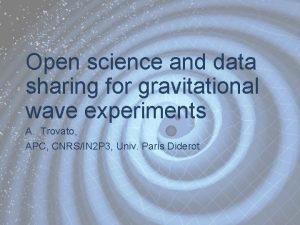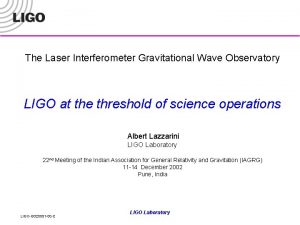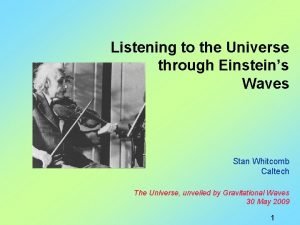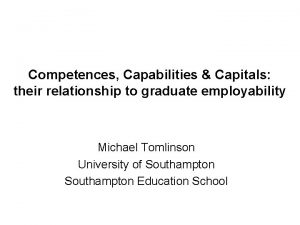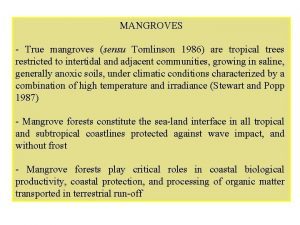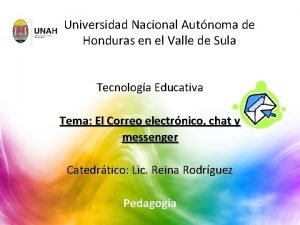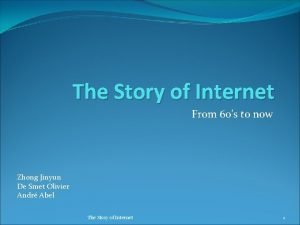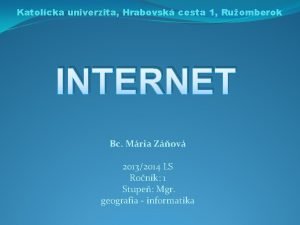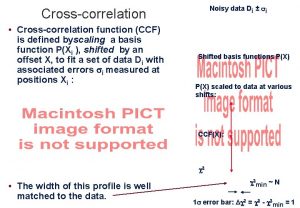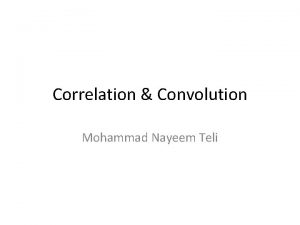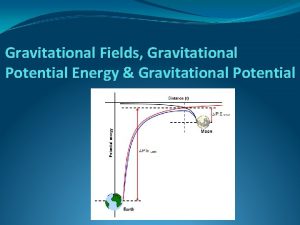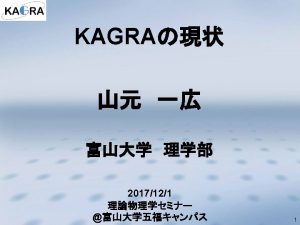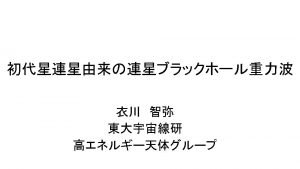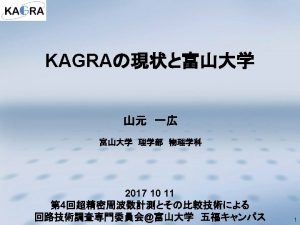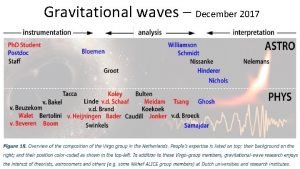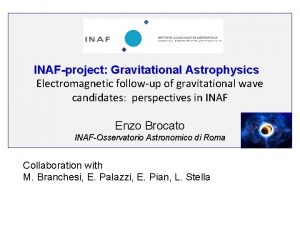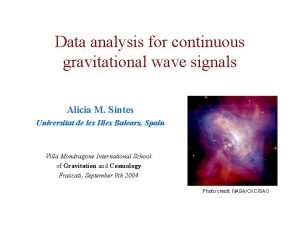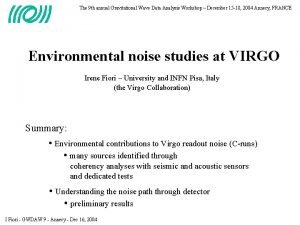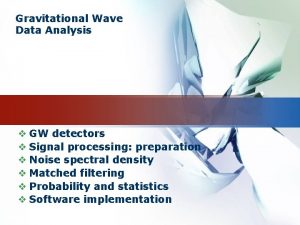CrossCorrelation in Gravitational Wave Data Analysis Clive Tomlinson














- Slides: 14

Cross-Correlation in Gravitational Wave Data Analysis Clive Tomlinson

Gravitational Waves • Einstein’s General Theory Of Relativity predicts the existence of gravitational waves (1916). Yet to be directly detected. h+ h× • Cause a time varying curvature of space-time, propagating at the speed of light. • Sources have non-zero quadrupole moment and large mass-energy flux. • GW radiation carries energy away from emitting system/object. GR theory • Induce an extremely small spatial strain, h ≈ 10 -21 → large scale detector. • Best indirect evidence of GWs from observation of binary pulsar PSR 1913+16. Observation of binary pulsar PSR 1913+16 by Taylor & Weisberg

Electromagnetic Waves Gravitational Waves • Light interacts strongly with matter and may be absorbed/dispersed or in some cases never detected. • GWs interact very weakly with matter. The Universe is virtually transparent to GWs. • Easy to detect – eyes, astronomy. • Very difficult to detect – not detected. • Light frequencies emitted dependent upon the composition and processes occurring in outermost layers of source. • GW frequencies depend upon bulk internal and external dynamics of the system. • Frequency range: EM spectrum. • Frequency range: Audio. • Detailed image formation. • Direct probe of internal motion. In a sense we can see the Universe with EM waves and listen with GWs. If detected GWs will offer a new window on the Universe.

Expected Sources of GWs Compact Binary System Continuous Neutron Star Burst Stochastic Asymmetric core collapse supernovae Binary merger Astrophysical Cosmological

Interferometric Gravitational Wave Detection • Detection principle essentially Michelson Interferometric length sensing. • Several Km-scale interferometric detectors built. LIGO (USA), VIRGO (ITALY), GEO 600 (Germany), TAMA 300 (Japan). • Network of three detectors permits GW source direction estimation which can be passed to robotic telescopes to search for coincident electromagnetic events. • Motivates the need for real time analysis. 4 Km = L LIGO Hanford 4 Km detector ∆L ≈ -18 m 10 =t and s u ho ize s h t on o ot f pr h = ∆L/L

Gravitational Wave Detector Noise GW detection is hindered by the presence of many sources of noise. Fundamental noise – intrinsic randomness of the physical detection principle. • Laser power shot noise – high frequency (higher laser power). • Thermal noise – mid frequency (ALIGO-cooling). Technical noise – experimental design. • Power line harmonics (e. g. 60 Hz USA) (Signal processing). • Thermal resonances of mirror suspensions (Signal processing). • Scattering/absorption of laser light by particles (Operate in high vacuum ). • Stray light (Sealed light paths and light baffles). External noise – environmental disturbance of the experiment. • Seismic activity (Pendulum suspension of mirrors). • Anthropogenic – vehicular activity, pedestrian (Monitoring). • Gravity gradient noise – local changes in density underground.

Strain Sensitivity of LIGO Interferometers 60 Hz mains seismic thermal Shot noise

GW Data Analysis Noise severely impairs GW signal detection algorithms ∆L ≈ 10 -18 and m so raw strain data requires two main signal processing steps. • Whitening – equalise the power spectrum. • Line removal – subtract narrow band noise. • We have developed PIIR, a line removal and monitoring tool.

Line Subtraction at GEO 600 • Lines may vary slightly in frequency, amplitude and phase. I <ω> PIIR A(t) sin(ω(t)+φ(t)) × • PIIR filter is a data driven oscillator which locks onto line frequency and phase. 2 <ω> I 2 + Q 2 Q PIIR • Successful implementation at GEO 600. asd Hz -1/2 after Automatic cumulative asd Hz -1/2 Magnitude before frequency (Hz) A(t) frequency (Hz) I φ(t)

Signal Detection using Cross-Correlation • Modelled waveforms – Matched Template • Cross-correlate detector output with waveform. • Optimal if signal is known. • Large template banks. • Unmodelled • Excess power or CC multiple detector output. • Current approach to CC • FFT blocks of data FFT-1 gives CC. • FFT is fast, Nlog 2 N cf. time domain CC N 2. time(s) • Problems with this method • edge effects of windowing FFT. • compromise time resolution. • We have developed a rapid time domain estimator of CC and propose a comparison with methods currently in use. time(s)

Time Domain Cross-Correlation Estimation CC approximation (RTCC) Cn = (1 -w) Cn-1 + wxnyn-l l l w = 1 – e -1/N Discrete CC definition N-1 Cnl = ∑ xn-iyn-l-i i=0 Gaussianity • Performance CLT (σ=0. 0316) RTCC (σ=0. 0315) • Computes CC faster than sampling rate 16384/s. • Symmetric treatment of input data. • RTCC output characterisation Ln • Detect signals with low SNR. • Demonstrated output of CC noise is Gaussian in applied use. • Suitable for event trigger generation. 5σ

Sensitivity Demonstration Sine wave unit amplitude buried in Gaussian noise (σ=8). Sine + Noise RTCC output Integrated lags

Current Work – Offline/Online RTCC Implementation • Implement RTCC/PIIR into existing LIGO detector software (GDS/DMT). • Testing sensitivity of RTCC on archived detector data (Frames) (Big Dog ? ).

Future Work • Comparison of PIIR line tracking/removal with existing methods. • Blind signal injection analysis. • Contrast detection efficiency of existing event trigger algorithms with our CC estimator as input and/or triggers we develop. • Blind signal injection analysis. • Investigate potential of RTCC as a detector diagnostic/commissioning tool. • Investigate the Frequentist and Bayesian approaches to data analysis in this field. End
 Gravitational wave open science center
Gravitational wave open science center Gravitational wave
Gravitational wave Gravitational wave
Gravitational wave Giant wave murmurs across universe
Giant wave murmurs across universe Wave could hear murmurs across universe
Wave could hear murmurs across universe Tomlinson 2000
Tomlinson 2000 Graduate capital model
Graduate capital model Tomlinson 1986
Tomlinson 1986 Tomlinson v congleton
Tomlinson v congleton Tomlinson's equalizer
Tomlinson's equalizer Ray tomlinson
Ray tomlinson Yosectro
Yosectro First email ray tomlinson
First email ray tomlinson Ray tomlinson wikipedia
Ray tomlinson wikipedia Electromagnetic waves are longitudinal waves true or false
Electromagnetic waves are longitudinal waves true or false
